Comprehensive Risk Assessment of High Temperature Disaster to Kiwifruit in Shaanxi Province, China
Abstract
:1. Introduction
2. Study Area and Data Sources
3. Research Methods
3.1. Framework for High-Temperature Disaster Risk Assessment
3.2. Selection Risk Assessment Indexes
3.2.1. Selection of Hazard Indexes
3.2.2. Selection of Vulnerability Indexes
- (1)
- Yield reduction rate (r) and yield reduction coefficient of variation (v)
- (2)
- Probability occurrence of yield reduction rate (p)
- (3)
- Meteorological sensitiveness index
- (4)
- Selection of adaptive capacity indexes
3.2.3. Selection of Exposure Indexes
- (1)
- Planted area as a proportion of the province’s planted area
- (2)
- Climate suitability
3.2.4. Selection of Disaster Prevention and Mitigation Capacity Indexes
3.3. High-Temperature Disaster Assessment Index System
3.4. High Temperature Disaster Risk Assessment Model
3.5. Standardized Treatment of Assessment Indexes
3.6. Methodology
3.6.1. Combination Weighting Method
- (1)
- AHP method to determine subjective weights of indexes
- (2)
- Entropy weight method to determine objective weights of indexes
- (3)
- Combination weighting method
3.6.2. Mann–Kendall Method
4. Results and Discussion
4.1. Comprehensive Assessment of High-Temperature Disaster Hazards
4.1.1. Analysis of the Variation Characteristics of High-Temperature Events Frequency
4.1.2. Analysis of Spatial Patterns of High-Temperature Disaster Hazard
4.2. Comprehensive Assessment of High-Temperature Disaster Vulnerability
4.2.1. Changes in Kiwifruit Yield by County
4.2.2. Analysis of Spatial Patterns of High-Temperature Disaster Vulnerability
4.3. Comprehensive Assessment of High-Temperature Disaster Exposure
4.3.1. Analysis of the Climatic Suitability of Kiwifruit
4.3.2. Analysis of Spatial Patterns of High-Temperature Disaster Exposure
4.4. Comprehensive Assessment of High-Temperature Disaster Prevention and Mitigation Capacity
4.5. Risk Assessment of High-Temperature Disasters
4.5.1. Analysis of Spatial Patterns Risk of High-Temperature Disasters
4.5.2. Validation of Risk Evaluation Results
4.6. Research Limitations and Prospects
4.7. Recommendations
5. Conclusions
- (1)
- From five aspects, heat, light, water, soil resources and topography, 16 indexes were selected that have an important influence on the growth and development of kiwifruit, and a climate suitability zoning of kiwifruit in Shaanxi Province was carried out. We found that the areas of high suitability were located in the Guanzhong Plain region, including Weinan, southern Xianyang, northern Xi’an and central-eastern Baoji. The highly and moderately suitable area accounted for 42.21% of the study area.
- (2)
- Areas at high risk of high-temperature disaster are located in Ankang, Weinan, southern Xianyang and northern Xi’an, accounting for 22.7% of the study area. As a relatively concentrated area of agricultural production in the plains, the risk of high-temperature disasters poses a significant threat to the region’s agricultural development. The south-western part of the study area has a low risk and is favorable to the kiwifruit industry.
- (3)
- By comparing with historical disaster data, the areas where high-temperature disasters occurred are more consistent with our findings and the study has a high degree of confidence.
Author Contributions
Funding
Institutional Review Board Statement
Informed Consent Statement
Data Availability Statement
Acknowledgments
Conflicts of Interest
References
- Tollefson, J. IPCC climate report: Earth is warmer than it’s been in 125,000 years. Nature 2021, 596, 171–172. [Google Scholar] [CrossRef] [PubMed]
- Alexander, L.V.; Zhang, X.; Peterson, T.C.; Caesar, J.; Gleason, B.; Tank, A.K.; Haylock, M.; Collins, D.; Trewin, B.; Rahimzadeh, F.; et al. Global observed changes in daily climate extremes of temperature and precipitation. J. Geophys. Res. Space Phys. 2006, 111. [Google Scholar] [CrossRef] [Green Version]
- Hatfield, J.L.; Boote, K.; Kimball, B.A.; Ziska, L.H.; Izaurralde, R.C.; Ort, D.; Thomson, A.M.; Wolfe, D. Climate impacts on agriculture: Implications for crop production. Agron. J. 2011, 103, 351–370. [Google Scholar] [CrossRef] [Green Version]
- Luo, Q. Temperature thresholds and crop production: A review. Clim. Chang. 2011, 109, 583–598. [Google Scholar] [CrossRef]
- Zhang, Y.; Qu, H.; Yang, X.; Wang, M.; Qin, N.; Zou, Y. Cropping system optimization for drought prevention and disaster reduction with a risk assessment model in Sichuan Province. Glob. Ecol. Conserv. 2020, 23, e01095. [Google Scholar] [CrossRef]
- Hatfield, J.L.; Prueger, J.H. “Challenge for future agriculture.”. In Crop Wild Relatives and Climate Change; Redden, R., Yadav, S.S., Maxted, N., Dulloo, M.E., Guarino, L., Smith, P., Eds.; Wiley Publishing: Hoboken, NJ, USA, 2015; pp. 24–43. [Google Scholar] [CrossRef]
- Reyes, J.J.; Elias, E. Spatio-temporal variation of crop loss in the United States from 2001 to 2016. Environ. Res. Lett. 2019, 14, 074017. [Google Scholar] [CrossRef]
- FAOSTAT. Kiwifruit Production of the World and China in 2014. Available online: http://faostat3.fao.org/browse/Q/QC/E (accessed on 1 August 2021).
- Zheng, S.; Cui, N.; Gong, D.; Wang, Y.; Hu, X.; Feng, Y.; Zhang, Y. Relationship between stable carbon isotope discrimination and water use efficiency under deficit drip irrigation of kiwifruit in the humid areas of South China. Agric. Water Manag. 2020, 240, 106300. [Google Scholar] [CrossRef]
- China Statistics Press. The Statistical Yearbooks of Shaanxi; China Statistics Press: Beijing, China, 2019. [Google Scholar]
- He, B.; Wang, Q.J.; Wu, D.; Zhou, B.B. Spatio-temporal characteristics of agricultural drought in Shaanxi Province, China based on integrated disaster risk index. Ying Yong Sheng Tai Xue Bao J. Appl. Ecol. 2016, 27, 3299–3306. [Google Scholar]
- Zhang, L.; Song, W.; Song, W. Assessment of agricultural drought risk in the lancang-mekong region, South East Asia. Int. J. Environ. Res. Public Health 2020, 17, 6153. [Google Scholar] [CrossRef] [PubMed]
- Guo, H.; Chen, J.; Pan, C. Assessment on agricultural drought vulnerability and spatial heterogeneity study in China. Int. J. Environ. Res. Public Health 2021, 18, 4449. [Google Scholar] [CrossRef] [PubMed]
- Cheng, Y.-X.; Huang, J.; Han, Z.-L.; Guo, J.-P.; Zhao, Y.-X.; Wang, X.-Z.; Guo, R.-F. Cold damage risk assessment of double cropping rice in hunan, China. J. Integr. Agric. 2013, 12, 352–363. [Google Scholar] [CrossRef]
- Chatrabgoun, O.; Karimi, R.; Daneshkhah, A.; Abolfathi, S.; Nouri, H.; Esmaeilbeigi, M. Copula-based probabilistic assessment of intensity and duration of cold episodes: A case study of Malayer vineyard region. Agric. For. Meteorol. 2020, 295, 108150. [Google Scholar] [CrossRef]
- Scorzini, A.R.; Di Bacco, M.; Manella, G. Regional flood risk analysis for agricultural crops: Insights from the implementation of AGRIDE-c in central Italy. Int. J. Disaster Risk Reduct. 2021, 53, 101999. [Google Scholar] [CrossRef]
- Liu, Y.; You, M.; Zhu, J.; Wang, F.; Ran, R. Integrated risk assessment for agricultural drought and flood disasters based on entropy information diffusion theory in the middle and lower reaches of the Yangtze River, China. Int. J. Disaster Risk Reduct. 2019, 38, 101194. [Google Scholar] [CrossRef]
- Zhang, F.; Chen, Y.; Zhang, J.; Guo, E.; Wang, R.; Li, D. Dynamic drought risk assessment for maize based on crop simulation model and multi-source drought indices. J. Clean. Prod. 2019, 233, 100–114. [Google Scholar] [CrossRef]
- Zhang, J. Risk assessment of drought disaster in the maize-growing region of Songliao Plain, China. Agric. Ecosyst. Environ. 2004, 102, 133–153. [Google Scholar] [CrossRef]
- Li, Z.; Zhang, Z.; Zhang, L. Improving regional wheat drought risk assessment for insurance application by integrating scenario-driven crop model, machine learning, and satellite data. Agric. Syst. 2021, 191, 103141. [Google Scholar] [CrossRef]
- Zhang, L.; Chu, Q.-Q.; Jiang, Y.-L.; Chen, F.; Lei, Y.-D. Impacts of climate change on drought risk of winter wheat in the North China Plain. J. Integr. Agric. 2021, 20, 2601–2612. [Google Scholar] [CrossRef]
- Wassmann, R.; Jagadish, S.V.K.; Heuer, S.; Ismail, A.; Redona, E.; Serraj, R.; Singh, R.K.; Howell, G.; Pathak, H.; Sumfleth, K. Climate change affecting rice production: The physiological and agronomic basis for possible adaptation strategies. Adv. Agron. 2009, 101, 59–122. [Google Scholar] [CrossRef]
- Julia, C.; Dingkuhn, M. Predicting temperature induced sterility of rice spikelets requires simulation of crop-generated microclimate. Eur. J. Agron. 2013, 49, 50–60. [Google Scholar] [CrossRef]
- Zhu, X.; Xu, K.; Liu, Y.; Guo, R.; Chen, L. Assessing the vulnerability and risk of maize to drought in China based on the AquaCrop model. Agric. Syst. 2021, 189, 103040. [Google Scholar] [CrossRef]
- Farhangfar, S.; Bannayan, M.; Khazaei, H.R.; Baygi, M.M. Vulnerability assessment of wheat and maize production affected by drought and climate change. Int. J. Disaster Risk Reduct. 2015, 13, 37–51. [Google Scholar] [CrossRef]
- Epule, T.E.; Ford, J.D.; Lwasa, S. Projections of maize yield vulnerability to droughts and adaptation options in Uganda. Land Use Policy 2017, 65, 154–163. [Google Scholar] [CrossRef]
- Luo, D.; Ye, L.; Sun, D. Risk evaluation of agricultural drought disaster using a grey cloud clustering model in Henan province, China. Int. J. Disaster Risk Reduct. 2020, 49, 101759. [Google Scholar] [CrossRef]
- Liu, Y.; Chen, J. Future global socioeconomic risk to droughts based on estimates of hazard, exposure, and vulnerability in a changing climate. Sci. Total. Environ. 2021, 751, 142159. [Google Scholar] [CrossRef] [PubMed]
- Carrão, H.; Naumann, G.; Barbosa, P. Mapping global patterns of drought risk: An empirical framework based on sub-national estimates of hazard, exposure and vulnerability. Glob. Environ. Chang. 2016, 39, 108–124. [Google Scholar] [CrossRef]
- Zhang, Y.; Wang, Y.; Niu, H. Effects of temperature, precipitation and carbon dioxide concentrations on the requirements for crop irrigation water in China under future climate scenarios. Sci. Total. Environ. 2019, 656, 373–387. [Google Scholar] [CrossRef] [PubMed]
- Macholdt, J.; Hadasch, S.; Piepho, H.-P.; Reckling, M.; Taghizadeh-Toosi, A.; Christensen, B. Yield variability trends of winter wheat and spring barley grown during 1932–2019 in the Askov Long-term Experiment. Field Crop. Res. 2021, 264, 108083. [Google Scholar] [CrossRef]
- Lieth, H.; Box, E. Evapotranspiration and primary productivity: C. W. Thornthwaite memorial model. Publ. Climatol. 1972, 25, 37–46. [Google Scholar]
- Lieth, H. Modeling the Primary Productivity of the World. Nature Res. 1975, 14, 237–263. [Google Scholar] [CrossRef]
- Yamada, E.S.M.; Sentelhas, P.C. Agro-climatic zoning of Jatropha curcas as a subside for crop planning and implementation in Brazil. Int. J. Biometeorol. 2014, 58, 1995–2010. [Google Scholar] [CrossRef]
- Garcia-Barreda, S.; Sánchez, S.; Marco, P.; Serrano-Notivoli, R. Agro-climatic zoning of Spanish forests naturally producing black truffle. Agric. For. Meteorol. 2019, 269–270, 231–238. [Google Scholar] [CrossRef]
- Hutchinson, M.F. Interpolating mean rainfall using thin plate smoothing splines. Int. J. Geogr. Inf. Syst. 1995, 9, 385–403. [Google Scholar] [CrossRef]
- Hijmans, R.J.; Cameron, S.E.; Parra, J.L.; Jones, P.G.; Jarvis, A. Very high resolution interpolated climate surfaces for global land areas. Int. J. Clim. 2005, 25, 1965–1978. [Google Scholar] [CrossRef]
- New, M.; Lister, D.; Hulme, M.; Makin, I. A high-resolution data set of surface climate over global land areas. Clim. Res. 2002, 21, 1–25. [Google Scholar] [CrossRef] [Green Version]
- Gentile, R.M.; Malepfane, N.M.; Dijssel, C.V.D.; Arnold, N.; Liu, J.; Müller, K. Comparing deep soil organic carbon stocks under kiwifruit and pasture land uses in New Zealand. Agric. Ecosyst. Environ. 2021, 306, 107190. [Google Scholar] [CrossRef]
- Huang, H. Biology, Genetic improvement, and cultivar development. Kiwifruit 2016, 5, 211–237. [Google Scholar] [CrossRef]
- Ma, Y.; Lu, X.; Li, K.; Wang, C.; Guna, A.; Zhang, J. Prediction of potential geographical distribution patterns of Actinidia arguta under different climate scenarios. Sustainability 2021, 13, 3526. [Google Scholar] [CrossRef]
- Wu, H.; Ma, T.; Kang, M.; Ai, F.; Zhang, J.; Dong, G.; Liu, J. A high-quality Actinidia chinensis (kiwifruit) genome. Hortic. Res. 2019, 6, 117. [Google Scholar] [CrossRef] [PubMed] [Green Version]
- Zhu, H. Kiwifruit; China Forestry Publishing House: Beijing, China, 2009. [Google Scholar]
- Liu, J.; Zhang, K. Comparative study on data standardization methods in comprehensive evaluation. Digit. Technol. Appl. 2018, 36, 84–85. [Google Scholar] [CrossRef]
- Saaty, T.L. The Analytical Hierrarchy Process; McGraw Hill: New York, NY, USA, 1980. [Google Scholar]
- Du, Y.; Zheng, Y.; Wu, G.; Tang, Y. Decision-making method of heavy-duty machine tool remanufacturing based on AHP-entropy weight and extension theory. J. Clean. Prod. 2020, 252, 119607. [Google Scholar] [CrossRef]
- Mon, D.-L.; Cheng, C.-H.; Lin, J.-C. Evaluating weapon system using fuzzy analytic hierarchy process based on entropy weight. Fuzzy Sets Syst. 1994, 62, 127–134. [Google Scholar] [CrossRef]
- Farhadinia, B. A Multiple criteria decision making model with entropy weight in an interval-transformed hesitant fuzzy environment. Cogn. Comput. 2017, 9, 513–525. [Google Scholar] [CrossRef]
- Li, L.; Liu, F. Evaluation of airport aviation security based on combined weight. J. Civ. Aviat. Univ. 2014, 32, 55–58. [Google Scholar]
- Guo, Y.; Wang, R.; Tong, Z.; Liu, X.; Zhang, J. Dynamic Evaluation and Regionalization of Maize Drought Vulnerability in the Midwest of Jilin Province. Sustainability 2019, 11, 4234. [Google Scholar] [CrossRef] [Green Version]
- Mitra, S.; Srivastava, P. Spatiotemporal variability of meteorological droughts in southeastern USA. Nat. Hazards 2017, 86, 1007–1038. [Google Scholar] [CrossRef]
- Mann, H.B. Nonparametric Tests Against Trend. Econometrica 1945, 13, 245–259. [Google Scholar] [CrossRef]
- Guna, A.; Zhang, J.; Tong, S.; Bao, Y.; Han, A.; Li, K. Effect of Climate Change on Maize Yield in the Growing Season: A Case Study of the Songliao Plain Maize Belt. Water 2019, 11, 2108. [Google Scholar] [CrossRef] [Green Version]
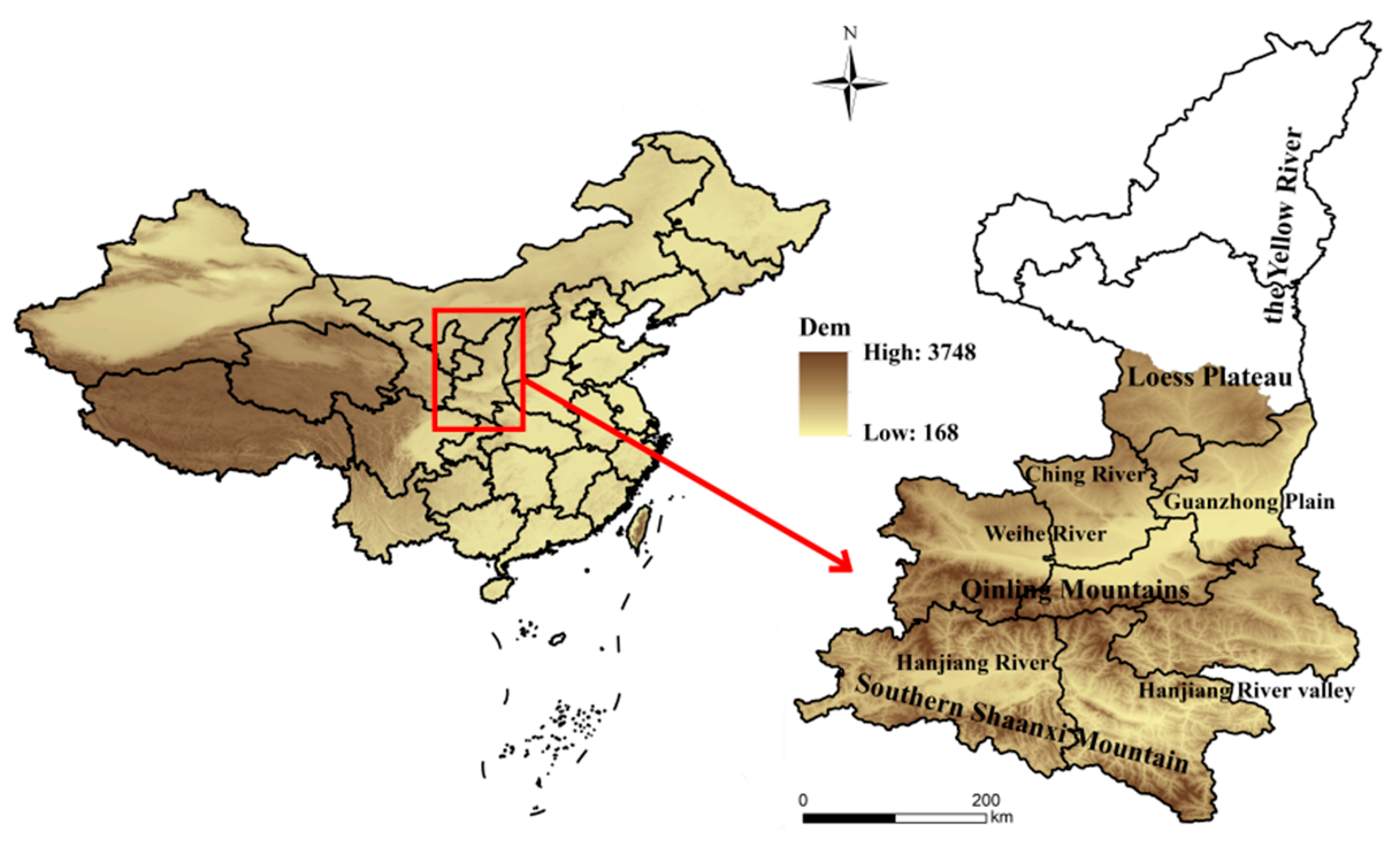

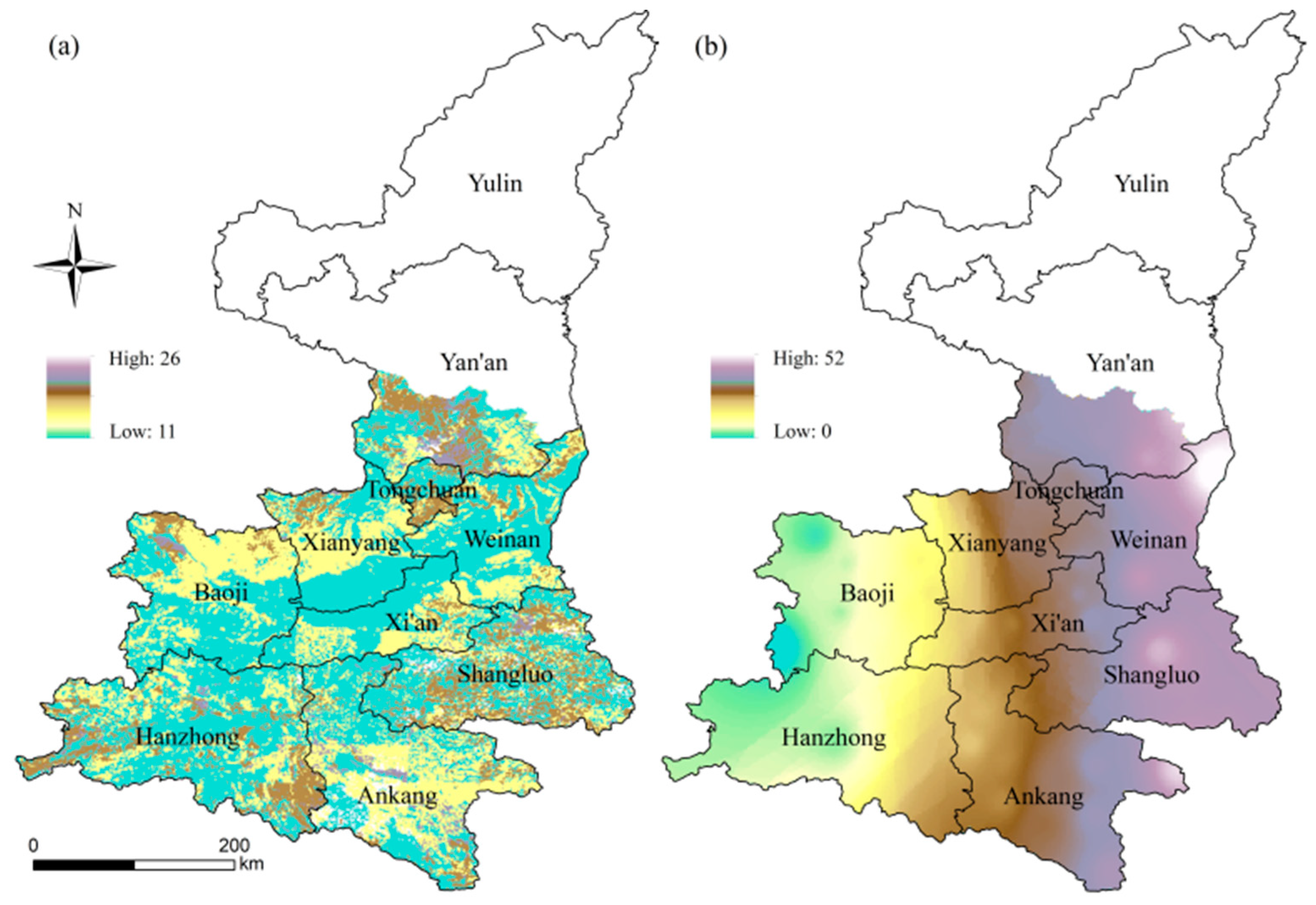
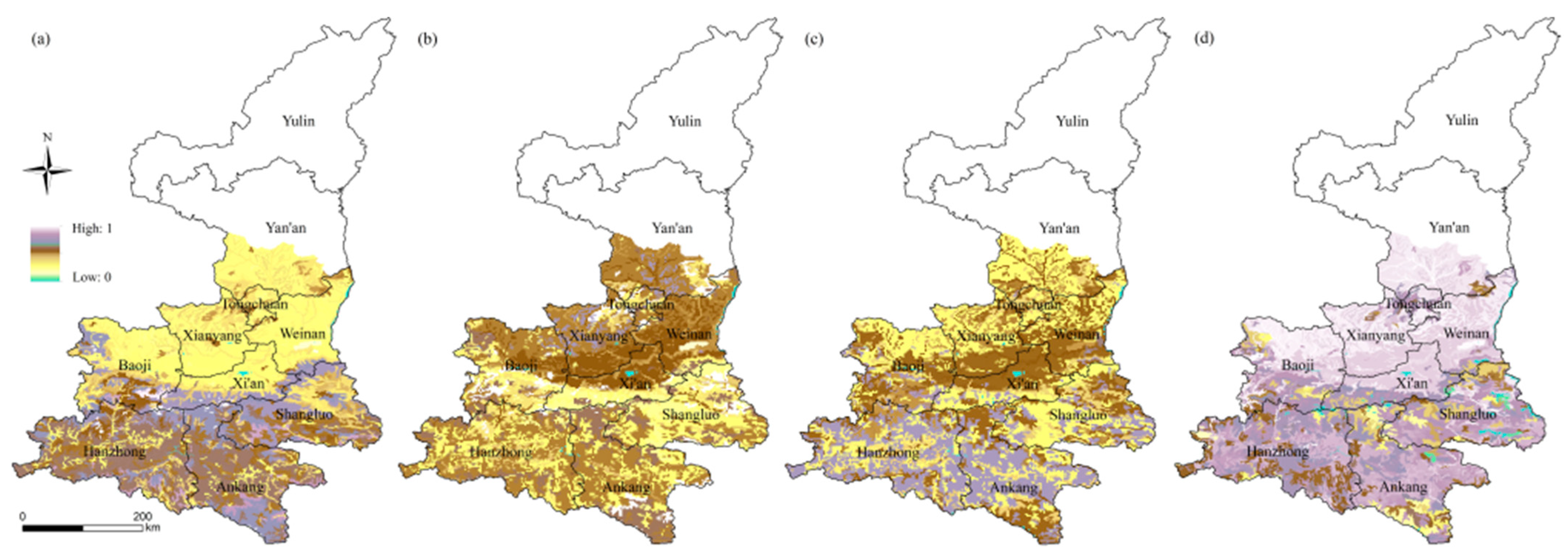

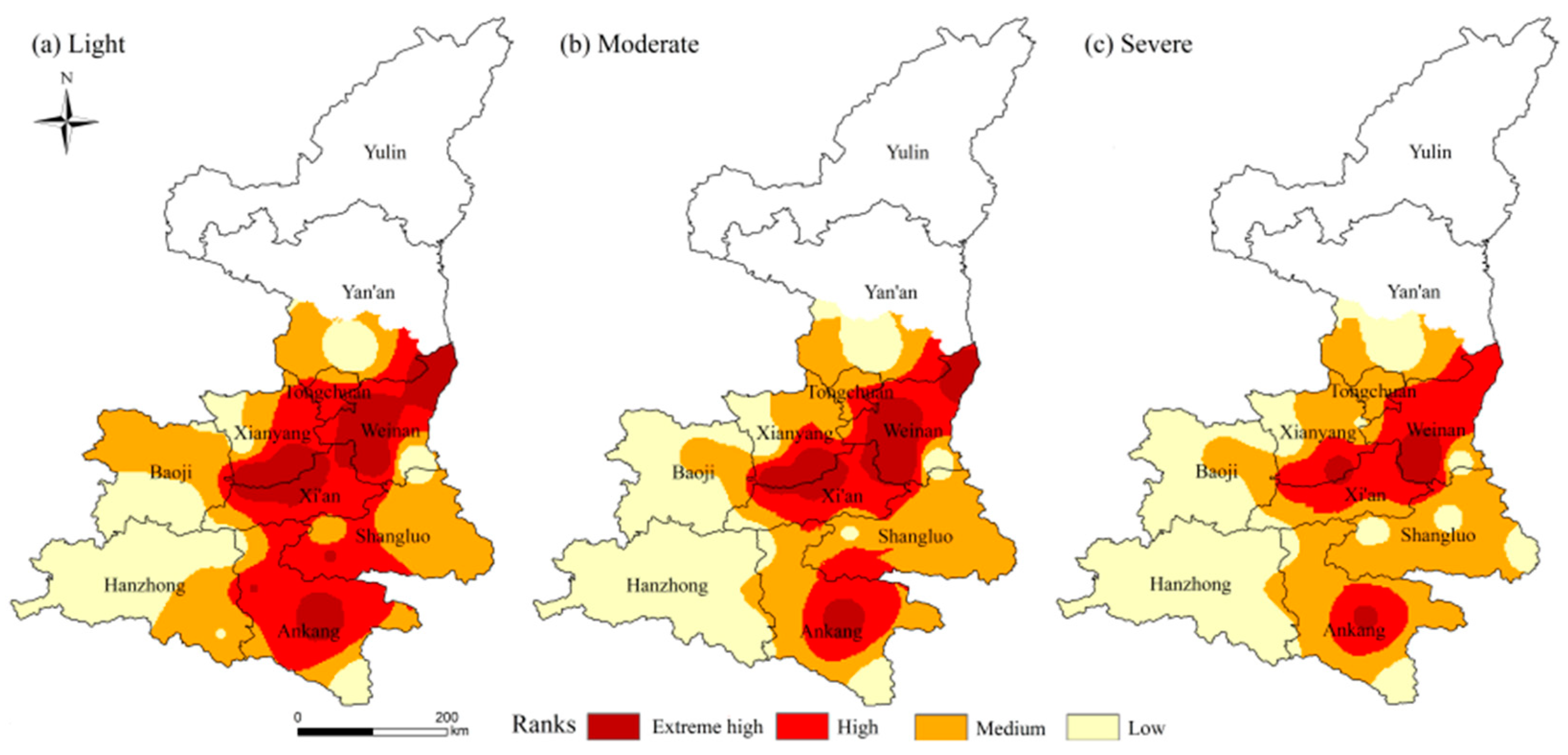

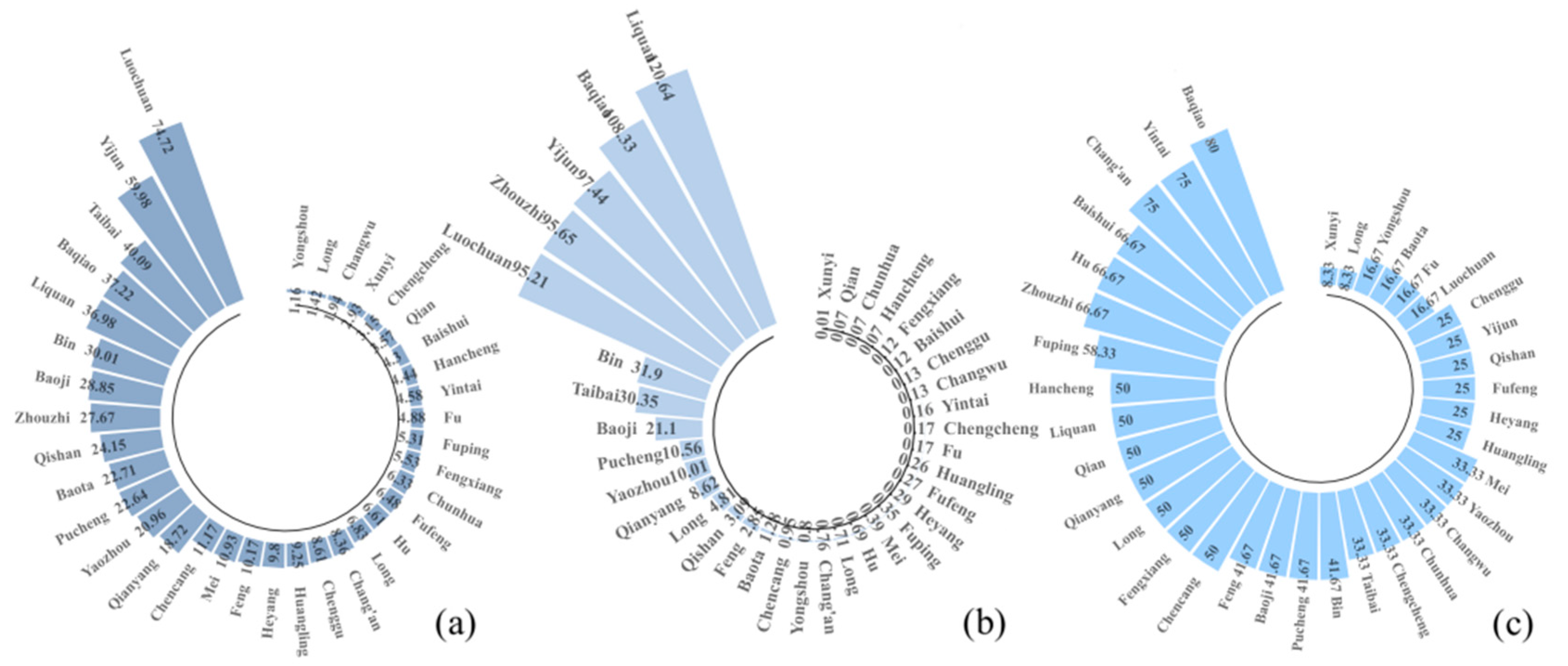
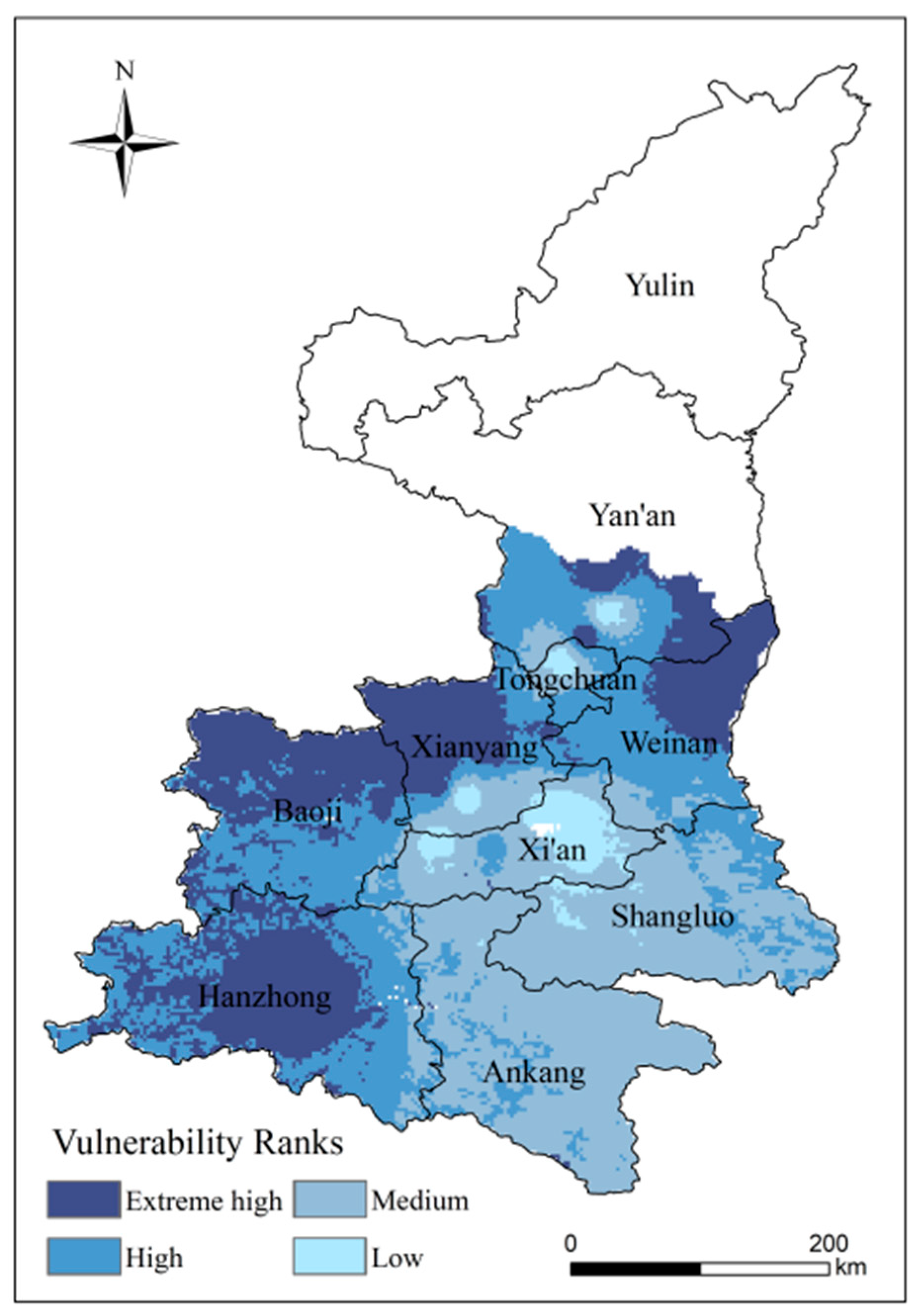
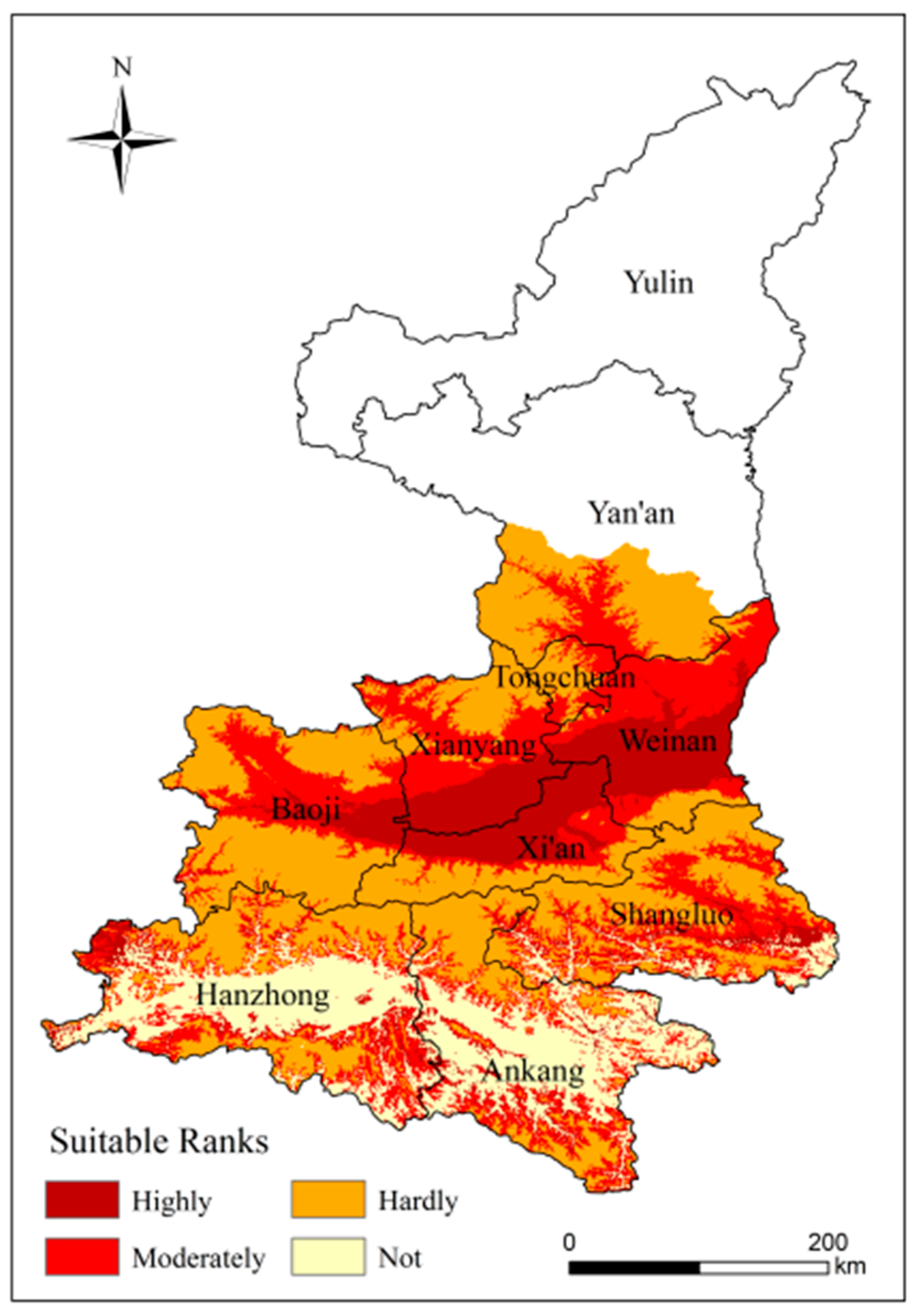



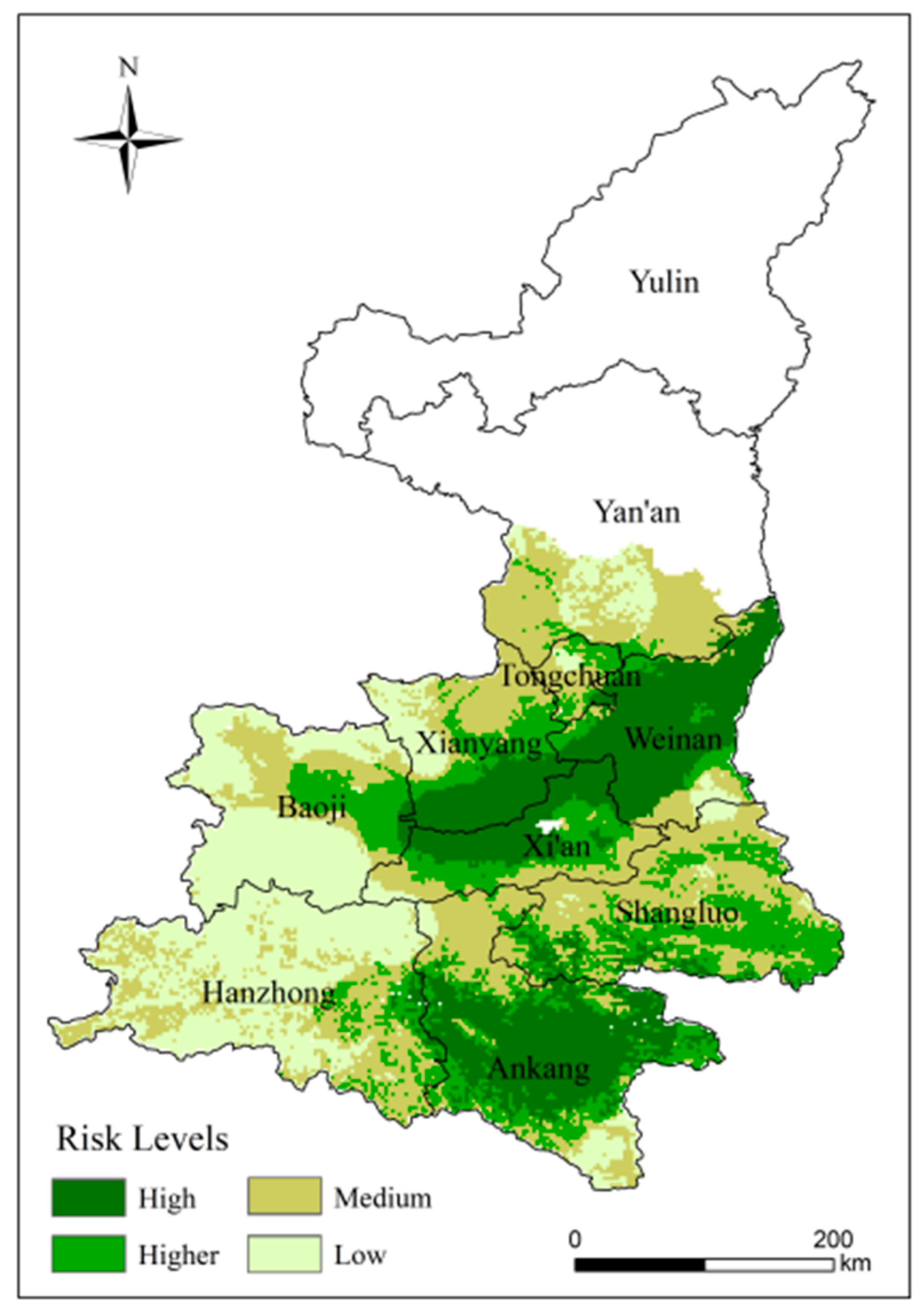
| Period | Index | Disaster Level | Threshold |
|---|---|---|---|
| June–August | Daily maximum temperature (TC/°C) | Light | 35 ≤ TC < 38 (3–4 day) |
| Moderate | 35 ≤ TC < 38 (5–8 day) | ||
| Severe | 35 ≤ TC < 38 (≥9 day) or 38 ≤ TC (≥2 day) |
| Suitable Ranks | Highly | Moderately | Hardly | Not | |
|---|---|---|---|---|---|
| Heat Resource | Average annual temperature (°C) | [14, 16] | [13, 14)(16, 18] | [10, 13)(18, 20] | (, 10)(20, ) |
| Average temperature in January (°C) | [6, 8] | [4.5, 6)(8, 9] | [3.4, 5)(9, 10] | (, 3)(10, ) | |
| Average temperature in March (°C) | [12, 14] | [11, 12)(14, 15] | [10, 11)(15, 16] | (, 10)(16, ) | |
| Average temperature in July (°C) | [22, 24] | [20, 22)(24, 26] | [17, 20)(26, 28] | (, 17)(28, ) | |
| ≥10 °C accumulated temperature (°C) | [4500, 5200] | [4000, 4500)(5200, 5600] | [3500, 4000)(5600, 6000] | (, 3500)(6000, ) | |
| Extreme minimum temperature (°C) (80% guaranteed) | [−3, ) | [–4, –3] | [–5, –4] | (, −5) | |
| Average diurnal temperature amplitude in August (°C) | [8, 12] | [6, 8) | [5, 6) | (, 5) | |
| Frost-free period (d) | [280, ) | [240, 280) | [200, 240) | (, 200) | |
| Light Resource | Annual sunshine hours (h) | [1200, 2000] | [900, 1200)(2000, 2200] | (, 900)(2200, 2500] | (2500, ) |
| Water Resource | Annual average relative humidity (%) | [79, 82] | [75, 79)(82, 85] | [72, 75) | (, 72)(85, ) |
| Total annual precipitation (mm) | [1200, 1500] | [1100, 1200)(1500, 1600] | [900, 1100)(1600, 1700] | (, 900)(1700, ) | |
| Topography | Elevation (m) | [500, 1200] | [350, 500)(1200, 1500] | [200, 350)(1500, 2000] | (, 200)(2000, ) |
| Slope (°) | [10, 20] | [5, 10)(20, 25] | [3, 5)(25, 30] | (, 3)(30, ) | |
| Slope direction | South/ Southeast/ Southwest | East/Northeast | West/Northwest | North | |
| Soil Resource | Soil pH | [5.5, 6.5] | [5.0, 5.5)(6.5, 7.0] | [4.5, 5.0)(7.0, 7.5] | (, 4.5)(7.5, ) |
| Soil type | Sandy loamy | Light loamy/ medium loamy | Heavy loamy | Clay/loamy clay | |
| Suitable Ranks | Highly | Moderately | Hardly |
|---|---|---|---|
| Threshold | 10–15 | 5–10 | 0–5 |
| Suitable Ranks | Highly | Moderately | Hardly | Not |
|---|---|---|---|---|
| Threshold | 0.65–1 | 0.36–0.65 | 0.12–0.36 | <0.12 |
| Factor | Sub-Factor | Index | Weight |
|---|---|---|---|
| Hazard (H) | Disaster-inducing factors (0.832) | Light high-temperature disaster (XH1) | 0.315 |
| Moderate high-temperature disaster (XH2) | 0.324 | ||
| Severe high-temperature disaster (XH3) | 0.361 | ||
| Formative Environment (0.168) | Gale days (XH4) | 0.090 | |
| Soil erosion (XH5) | 0.078 | ||
| Vulnerability (V) | Crop sensitiveness (S) | Yield reduction rate (XS1) | 0.348 |
| Yield reduction coefficient of variation (XS2) | 0.193 | ||
| Probability occurrence of yield reduction rate (XS3) | 0.276 | ||
| Meteorological sensitiveness index (XS4) | 0.183 | ||
| Adaptive capacity (A) | Soil organic matter (XA5) | 0.561 | |
| Soil total nitrogen content (XA6) | 0.142 | ||
| Soil total phosphorus content (XA7) | 0.139 | ||
| Soil total potassium content (XA8) | 0.158 | ||
| Exposure (E) | Climatic conditions | Climate suitability (XE1) | 0.481 |
| Planting conditions | Planted area as a proportion of the province’s planted area (XE2) | 0.519 | |
| Disaster prevention and mitigation capacity (C) | Agricultural production conditions factors | Total agricultural machinery power (XC1) | 0.211 |
| Fertilizer consumption (XC2) | 0.212 | ||
| Socioeconomic factors | Per capita disposable income of farmers (XC3) | 0.361 | |
| Rural electricity consumption per unit area (XC4) | 0.216 |
| Sort | Time | Extreme Heat Event Records |
|---|---|---|
| 1 | 1971.7.15–1971.7.28 | From mid-July to mid-August 1971, there were high temperatures and little rain in Guanzhong and southern Shaanxi. The daily maximum temperature in the Weinan area was above 36 °C. The high temperature aggravated the drought and affected 133,000 hectares of farmland, accounting for 35 per cent of the total autumn field area. * |
| 2 | 1972.8.7–1972.8.16 | From late July to mid-August 1972, extreme heat events occurred in Hanzhong and southern Shaanxi. Cotton and maize were affected. * |
| 3 | 1997.7.20–1997.7.27 | From 1961 to 2006, the average number of high-temperature days in the northwest region was 2.4 days, with the most years being 1997, when there were 6.4 days. In Shaanxi Province, the annual number of high-temperature days is above 50, with daily maximum temperatures reaching 38–40 °C in Weinan and Xi’an. ** |
| 4 | 2001.7.11–2001.7.23 | In mid to late July 2001, most areas in the middle and lower reaches of the Yangtze River and north of it in China experienced persistent extreme heat. The maximum temperature or the number of high-temperature days in many areas of southern Shaanxi Province exceeded the extreme values for the same period in history. The high temperatures and low rainfall were extremely detrimental to the growth of kiwifruit, citrus, grapes, apples and walnuts. *** |
| 5 | 2014.7.27–2014.8.5 | From 4 July to 10 August 2014, the longest consecutive run of high-temperature days in south-central Shaanxi was generally 10 days or more, reaching or exceeding historical extremes. Extreme high temperatures above 40 °C were experienced in local areas of Shaanxi. Intermittent hot weather occurred in southern Shaanxi, with Weinan reaching 39.1 °C. **** |
| 6 | 2016.8.12–2016.8.21 | July 20–August 26, a total of 30 provinces (autonomous regions and municipalities), 1653 counties (cities), had daily maximum temperatures of more than 35 °C high-temperature weather; the southeastern region of Shaanxi had amaximum temperature of 38–41 °C; Shaanxi Xunyang had one of up to 43.6 °C; 64 counties (cities) surpassed the local historical extreme; 11 provinces (autonomous regions and municipalities) in the south had an average number of high-temperature days of 19 days, the highest value since 1961. **** |
Publisher’s Note: MDPI stays neutral with regard to jurisdictional claims in published maps and institutional affiliations. |
© 2021 by the authors. Licensee MDPI, Basel, Switzerland. This article is an open access article distributed under the terms and conditions of the Creative Commons Attribution (CC BY) license (https://creativecommons.org/licenses/by/4.0/).
Share and Cite
Ma, Y.; Guga, S.; Xu, J.; Zhang, J.; Tong, Z.; Liu, X. Comprehensive Risk Assessment of High Temperature Disaster to Kiwifruit in Shaanxi Province, China. Int. J. Environ. Res. Public Health 2021, 18, 10437. https://doi.org/10.3390/ijerph181910437
Ma Y, Guga S, Xu J, Zhang J, Tong Z, Liu X. Comprehensive Risk Assessment of High Temperature Disaster to Kiwifruit in Shaanxi Province, China. International Journal of Environmental Research and Public Health. 2021; 18(19):10437. https://doi.org/10.3390/ijerph181910437
Chicago/Turabian StyleMa, Yining, Suri Guga, Jie Xu, Jiquan Zhang, Zhijun Tong, and Xingpeng Liu. 2021. "Comprehensive Risk Assessment of High Temperature Disaster to Kiwifruit in Shaanxi Province, China" International Journal of Environmental Research and Public Health 18, no. 19: 10437. https://doi.org/10.3390/ijerph181910437
APA StyleMa, Y., Guga, S., Xu, J., Zhang, J., Tong, Z., & Liu, X. (2021). Comprehensive Risk Assessment of High Temperature Disaster to Kiwifruit in Shaanxi Province, China. International Journal of Environmental Research and Public Health, 18(19), 10437. https://doi.org/10.3390/ijerph181910437








